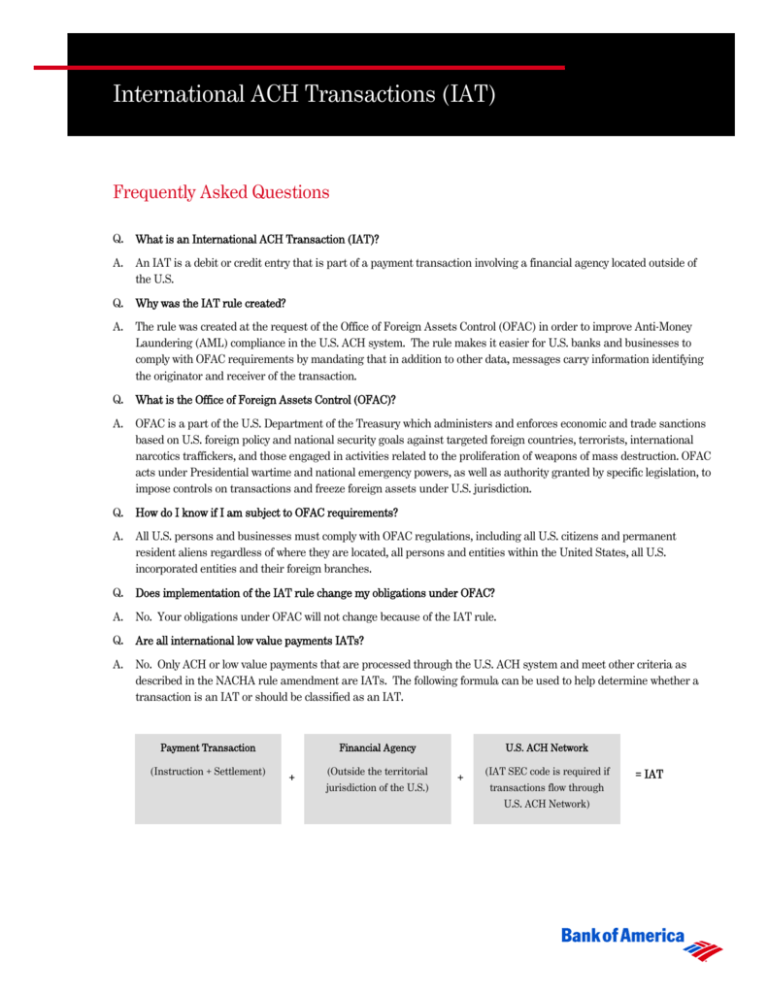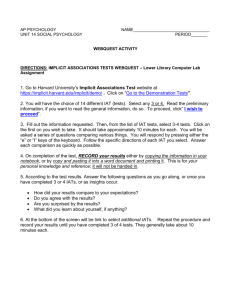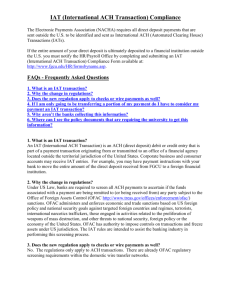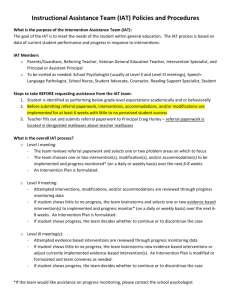International ACH Transactions (IAT)
advertisement

International ACH Transactions (IAT) Frequently Asked Questions Q. What is an International ACH Transaction (IAT)? A. An IAT is a debit or credit entry that is part of a payment transaction involving a financial agency located outside of the U.S. Q. Why was the IAT rule created? A. The rule was created at the request of the Office of Foreign Assets Control (OFAC) in order to improve Anti-Money Laundering (AML) compliance in the U.S. ACH system. The rule makes it easier for U.S. banks and businesses to comply with OFAC requirements by mandating that in addition to other data, messages carry information identifying the originator and receiver of the transaction. Q. What is the Office of Foreign Assets Control (OFAC)? A. OFAC is a part of the U.S. Department of the Treasury which administers and enforces economic and trade sanctions based on U.S. foreign policy and national security goals against targeted foreign countries, terrorists, international narcotics traffickers, and those engaged in activities related to the proliferation of weapons of mass destruction. OFAC acts under Presidential wartime and national emergency powers, as well as authority granted by specific legislation, to impose controls on transactions and freeze foreign assets under U.S. jurisdiction. Q. How do I know if I am subject to OFAC requirements? A. All U.S. persons and businesses must comply with OFAC regulations, including all U.S. citizens and permanent resident aliens regardless of where they are located, all persons and entities within the United States, all U.S. incorporated entities and their foreign branches. Q. Does implementation of the IAT rule change my obligations under OFAC? A. No. Your obligations under OFAC will not change because of the IAT rule. Q. Are all international low value payments IATs? A. No. Only ACH or low value payments that are processed through the U.S. ACH system and meet other criteria as described in the NACHA rule amendment are IATs. The following formula can be used to help determine whether a transaction is an IAT or should be classified as an IAT. Payment Transaction (Instruction + Settlement) Financial Agency + (Outside the territorial jurisdiction of the U.S.) U.S. ACH Network + (IAT SEC code is required if transactions flow through U.S. ACH Network) = IAT Q. Does the physical location of the originator and/or the receiver make a payment an IAT? A. No, the physical location(s) of the originator and/or the receiver do not determine if an ACH payment is an IAT. However, the domiciling locations of the accounts involved are important in determining if an ACH payment is an IAT. Q. Are cross currency ACH/low value payments always considered IATs? A. No. Although cross currency payments may be IATs, the origination and receipt currencies are not factors in determining whether a payment is an IAT. Q. What additional information may need to be included in an IAT transaction? A. Each transaction must include the following information: Physical address of the originator including city, state, province, country and postal code Physical address of the receiver including city, state, province, country and postal code Correspondent bank name, identification number and branch country code if applicable Receiving bank name, identification number and branch country code Reason for the payment Each transaction may include optional remittance information. Q. Are stop payments allowed with IATs? A. Yes. There is no change in the ACH rules regarding processing of stop payments. Q. Can IATs be returned? A. Generally, IAT entries can be returned for any of the same reasons as other ACH entries. The specific IAT return codes can be found in the ACH Rules. However, the allowable return time-frame for IATs has been extended to 60 days. Q. Can I dishonor a return IAT? A. No, automated dishonored returns are not supported with the IAT SEC code. Any request for dishonor (or contested dishonor) must be handled outside the ACH network. Q. My company sells goods and services overseas to companies that pay me in U.S. dollars. Will I be receiving IATs? A. If your customers remit their payments to you using USD ACH credits, you may receive IATs. You also may receive IATs if your U.S. based remitters are funding their ACH payments with funds from accounts domiciled outside of the U.S. Q. My company is a subsidiary of an offshore corporation and my parent company funds my operating accounts. Are my U.S. ACH payments IATs? A. Yes, your payments are IATs if the transfers from your parent company are specifically to fund your U.S. ACH payments. Bank of America, NA. Member FDIC. ©2009 Bank of America Corporation. Q. My company is a subsidiary of an offshore corporation but I fund all of my payments through my U.S. domestic operations. Are my U.S. ACH payments IATs? A. No. If the source of funding for your U.S. ACH payments is in the U.S., your payments are not IATs. Q. How do I determine if the Bank of America products I use are impacted by the IAT rule? A. Please refer to the communications you received from Bank of America. If you have additional questions, please contact your Bank of America representative. Q. What do I do if I determine that the IAT rule applies to my payments and/or receipts activity at Bank of America? A. Please contact your Bank of America representative to discuss possible changes to your existing processes. Bank of America, NA. Member FDIC. ©2009 Bank of America Corporation.


